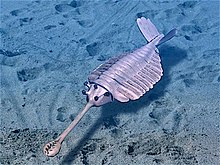Source: https://en.wikipedia.org/wiki/Cambrian_explosion
The fossil record as Darwin knew it seemed to suggest that the major metazoan groups appeared in a few million years of the early to mid-Cambrian, and even in the 1980s this still appeared to be the case.[15][16]
However, evidence of Precambrian metazoa is gradually accumulating. If the Ediacaran Kimberella was a mollusc-like protostome (one of the two main groups of coelomates),[20][61] the protostome and deuterostome lineages must have split significantly before 550 million years ago (deuterostomes are the other main group of coelomates).[94] Even if it is not a protostome, it is widely accepted as a bilaterian.[65][94] Since fossils of rather modern-looking Cnidarians (jellyfish-like organisms) have been found in the Doushantuo lagerstätte, the Cnidarian and bilaterian lineages must have diverged well over 580 million years ago.[94]
Trace fossils[59] and predatory borings in Cloudina shells provide further evidence of Ediacaran animals.[95] Some fossils from the Doushantuo formation have been interpreted as embryos and one (Vernanimalcula) as a bilaterian coelomate, although these interpretations are not universally accepted.[48][49][96] Earlier still, predatory pressure has acted on stromatolites and acritarchs since around 1,250 million years ago.[44]
The presence of Precambrian animals somewhat dampens the "bang" of the explosion: not only was the appearance of animals gradual, but their evolutionary radiation ("diversification") may also not have been as rapid as once thought. Indeed, statistical analysis shows that the Cambrian explosion was no faster than any of the other radiations in animals' history.[note 5] However, it does seem that some innovations linked to the explosion – such as resistant armour – only evolved once in the animal lineage; this makes a lengthy Precambrian animal lineage harder to defend.[98] Further, the conventional view that all the phyla arose in the Cambrian is flawed; while the phyla may have diversified in this time period, representatives of the crown-groups of many phyla do not appear until much later in the Phanerozoic.[53] Further, the mineralized phyla that form the basis of the fossil record may not be representative of other phyla, since most mineralized phyla originated in a benthic setting. The fossil record is consistent with a Cambrian Explosion that was limited to the benthos, with pelagic phyla evolving much later.[53]
Ecological complexity among marine animals increased in the Cambrian, as well later in the Ordovician.[5] However, recent research has overthrown the once-popular idea that disparity was exceptionally high throughout the Cambrian, before subsequently decreasing.[99] In fact, disparity remains relatively low throughout the Cambrian, with modern levels of disparity only attained after the early Ordovician radiation.[5]
The diversity of many Cambrian assemblages is similar to today's,[100][91] and at a high (class/phylum) level, diversity is thought by some to have risen relatively smoothly through the Cambrian, stabilizing somewhat in the Ordovician.[101] This interpretation, however, glosses over the astonishing and fundamental pattern of basal polytomy and phylogenetic telescoping at or near the Cambrian boundary, as seen in most major animal lineages.[102] Thus Harry Blackmore Whittington's questions regarding the abrupt nature of the Cambrian explosion remain, and have yet to be satisfactorily answered.[103]
A Medley of Potpourri is just what it says; various thoughts, opinions, ruminations, and contemplations on a variety of subjects.
Search This Blog
-
From Wikipedia, the free encyclopedia Islamic State of Iraq and the Levant الدولة الإسلامية في العراق والشام ( ...
-
From Wikipedia, the free encyclopedia A reproduction of the palm -leaf manuscript in Siddham script ...

